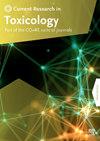A long-term mouse testis organ culture system to identify germ cell damage induced by chemotherapy
IF 2.9
Q2 TOXICOLOGY
引用次数: 0
Abstract
We previously developed the acrosin-green fluorescent protein (GFP) transgenic neonatal mouse organ culture system for rapid and accurate assessment of testicular toxicity. This system effectively evaluates drug-induced toxicity in male germ cells before meiotic entry but cannot assess post-meiotic germ cell toxicity. For many chemicals, the specific stage of germ cell differentiation that is susceptible to toxicity remains unclear, highlighting the need for new methods. In this study, we incubated neonatal mouse testis organ cultures for 35 days to allow post-meiotic cells to develop. The tissue was then exposed to cisplatin to determine the cells that are targeted and to assess the reversibility of the toxicity. We monitored changes in tissue volume and GFP fluorescence, which tracks the progression of spermatogenesis, and confirmed findings by histological analysis. Cisplatin inhibited tissue growth and reduced GFP fluorescence in a concentration-dependent manner. Higher concentrations targeted not only spermatogonia, but also spermatocytes and spermatids. Recovery from toxicity was observed at clinically relevant doses. This study demonstrates that long-term mouse testis organ culture can be used to assess testicular toxicity, enabling the identification of specific germ cell stages targeted by chemicals such as cisplatin.

长期小鼠睾丸器官培养系统鉴定化疗引起的生殖细胞损伤
为了快速准确地评估睾丸毒性,我们先前开发了转基因顶蛋白绿色荧光蛋白(GFP)新生小鼠器官培养系统。该系统能有效评估减数分裂前男性生殖细胞的药物毒性,但不能评估减数分裂后生殖细胞的毒性。对于许多化学物质,生殖细胞分化的特定阶段易受毒性影响尚不清楚,这突出了对新方法的需求。在这项研究中,我们将新生小鼠睾丸器官培养35天,以使减数分裂后细胞发育。然后将组织暴露于顺铂以确定靶向细胞并评估毒性的可逆性。我们监测了组织体积和GFP荧光的变化,这可以追踪精子发生的进程,并通过组织学分析证实了这些发现。顺铂抑制组织生长并以浓度依赖性方式降低GFP荧光。高浓度不仅针对精原细胞,而且针对精母细胞和精母细胞。在临床相关剂量下观察到毒性恢复。该研究表明,长期的小鼠睾丸器官培养可用于评估睾丸毒性,从而能够识别顺铂等化学物质靶向的特定生殖细胞阶段。
本文章由计算机程序翻译,如有差异,请以英文原文为准。
求助全文
约1分钟内获得全文
求助全文
来源期刊

Current Research in Toxicology
Environmental Science-Health, Toxicology and Mutagenesis
CiteScore
4.70
自引率
3.00%
发文量
33
审稿时长
82 days
 求助内容:
求助内容: 应助结果提醒方式:
应助结果提醒方式:


